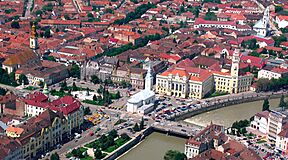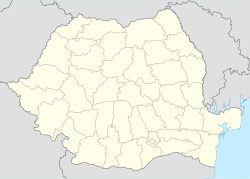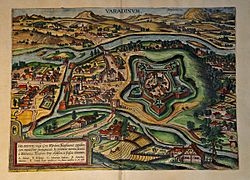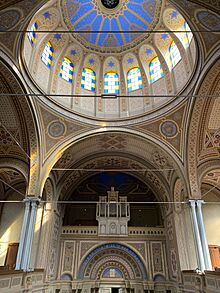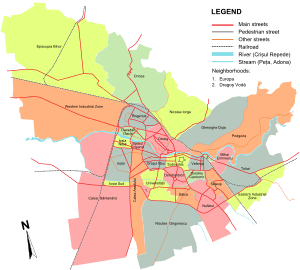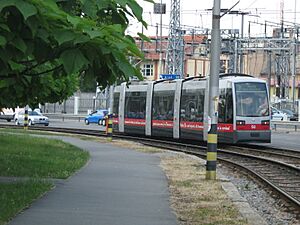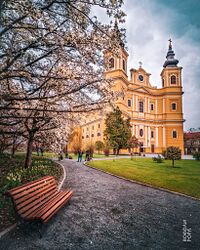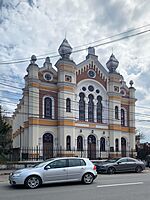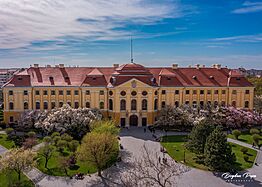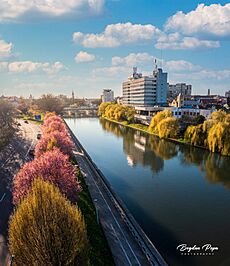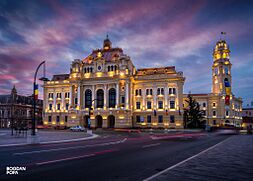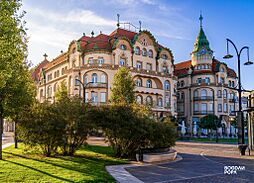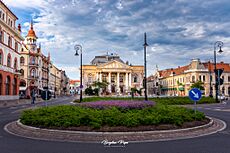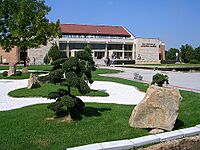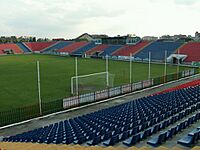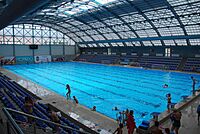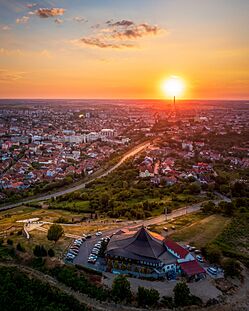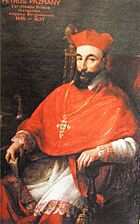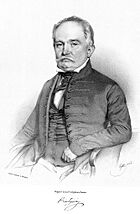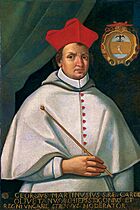Oradea facts for kids
Quick facts for kids
Oradea
Nagyvárad
|
|||
|---|---|---|---|
|
City
|
|||
|
From left: Overview of the city center, Oradea City Hall, Baroque Palace of Oradea, Black Eagle Palace, Astoria Hotel of Oradea, Oradea Neolog Synagogue
|
|||
|
|||
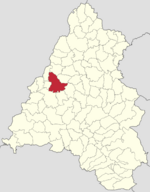
Location within Bihor County
|
|||
| Country | |||
| County | Bihor County | ||
| Area | |||
| • City | 115.56 km2 (44.62 sq mi) | ||
| Elevation | 142 m (466 ft) | ||
| Population
(2021 census)
|
|||
| • City | 183,105 | ||
| • Rank | 9th | ||
| • Density | 1,584.50/km2 (4,103.84/sq mi) | ||
| • Metro | 245,537 | ||
| Time zone | UTC+2 (EET) | ||
| • Summer (DST) | UTC+3 (EEST) | ||
| Postal code |
4101xx
|
||
| Area code(s) | (+40) 59 | ||
| Vehicle registration | BH | ||
| Official language | Romanian | ||
| Recognized minority language | Hungarian | ||
| Patron saint | Saint Ladislaus | ||
| Climate | Dfb | ||
Oradea is a big city in Romania, located in the western part of the country. It is the main city of Bihor County. Oradea is a very important place for business, social life, and culture in western Romania. The city sits among hills on the Crișana plain. The Crișul Repede river flows right through the middle, splitting the city into two nearly equal parts.
Oradea is about 10 kilometers (6 miles) from Borș, which is a major crossing point on Romania's border with Hungary. It is the ninth most populated city in Romania, based on the 2021 census. The city covers an area of 115.56 square kilometers (44.62 square miles).
People in Oradea enjoy a good standard of living, and it is known as one of the most livable cities in Romania. It is also a strong industrial center, home to some of Romania's biggest companies. Beyond its economy, Oradea is famous for its beautiful Art Nouveau buildings. It is even part of the Réseau Art Nouveau Network and the Art Nouveau European Route.
Contents
- What's in a Name? The Meaning of Oradea
- Where is Oradea? Exploring its Geography
- A Journey Through Time: The History of Oradea
- Who Lives in Oradea? Population and Communities
- How Oradea is Organized: City Quarters
- Oradea's Economy: How the City Works
- Getting Around: Transport in Oradea
- Learning and Growing: Education in Oradea
- Seeing the City: Oradea's Architecture
- Must-See Sights: Tourist Attractions in Oradea
- Game On! Sports in Oradea
- Friends Around the World: International Relations
- Oradea and Its Neighbors: Metropolitan Area
- Notable People from Oradea
- Images for kids
- See also
What's in a Name? The Meaning of Oradea
The name Oradea comes from the city's Hungarian name, Nagyvárad. People often called it Várad for short, and that's where the Romanian name came from.
In Hungarian, "Nagy" means great or large. This helped tell it apart from another town in Hungary called Kisvárda, where "kis" means little. "Vár" means castle or citadel, and "-ad" is a common ending for town names. So, Nagyvárad means "Great Castle-town."
The city also has a German name, Großwardein, and a Yiddish one, Groysvardeyn. In Turkish, it was known as Varat or Varad. Other old names include Latin Varadinum and Italian Gran Varadino.
Some older Romanian names for the city were Oradia, Oradea Mare ("Great Oradea"), Varadia Mare ("Great Varadia"), and Urbea Mare ("the Grand City").
Where is Oradea? Exploring its Geography
Oradea is located where the Crișana plain meets the Crișul Repede river basin. It sits about 126 meters (413 feet) above sea level. To the northeast, it is surrounded by the hills of Oradea. Most of the city is built on the flat land near the river. Oradea is also well-known for its warm thermal springs. The Crișul Repede river flows right through the city center, adding to its beauty.
What's the Weather Like? Oradea's Climate
Oradea has a climate with warm summers and moderately cold winters. It gets enough rain to support the local forests and plants.
The average temperature for the whole year is about 10.4°C (50.7°F). In July, the average is around 21°C (70°F), while in January, it's about -1.9°C (28.6°F). The city gets about 781 millimeters (30.7 inches) of rain each year. Most rain falls in June, and the least in late autumn and winter.
| Climate data for Oradea | |||||||||||||
|---|---|---|---|---|---|---|---|---|---|---|---|---|---|
| Month | Jan | Feb | Mar | Apr | May | Jun | Jul | Aug | Sep | Oct | Nov | Dec | Year |
| Record high °C (°F) | 15 (59) |
18 (64) |
24 (75) |
29 (84) |
32 (90) |
37 (99) |
38 (100) |
39 (102) |
35 (95) |
28 (82) |
21 (70) |
16 (61) |
39 (102) |
| Mean daily maximum °C (°F) | 1.4 (34.5) |
4.7 (40.5) |
10.7 (51.3) |
16.9 (62.4) |
22.1 (71.8) |
24.9 (76.8) |
27.1 (80.8) |
26.8 (80.2) |
23.0 (73.4) |
17.1 (62.8) |
9.3 (48.7) |
3.4 (38.1) |
15.6 (60.1) |
| Mean daily minimum °C (°F) | −5.2 (22.6) |
−2.7 (27.1) |
1.0 (33.8) |
5.5 (41.9) |
10.1 (50.2) |
12.9 (55.2) |
14.2 (57.6) |
13.9 (57.0) |
10.8 (51.4) |
5.9 (42.6) |
1.9 (35.4) |
−2.4 (27.7) |
5.5 (41.9) |
| Record low °C (°F) | −27 (−17) |
−27 (−17) |
−24 (−11) |
−8 (18) |
0 (32) |
7 (45) |
7 (45) |
7 (45) |
0 (32) |
−10 (14) |
−28 (−18) |
−28 (−18) |
−28 (−18) |
| Average precipitation mm (inches) | 39.5 (1.56) |
30.3 (1.19) |
36.5 (1.44) |
44.9 (1.77) |
63.4 (2.50) |
90.5 (3.56) |
69.1 (2.72) |
55.2 (2.17) |
39.9 (1.57) |
37.9 (1.49) |
46.6 (1.83) |
49.4 (1.94) |
603.2 (23.74) |
| Average snowy days | 8 | 7 | 3 | 0 | 0 | 0 | 0 | 0 | 0 | 0 | 3 | 7 | 28 |
| Source 1: Administrația Natională de Meteorologie | |||||||||||||
| Source 2: MSN Weather (for extreme and snowy days) | |||||||||||||
A Journey Through Time: The History of Oradea
Oradea is first mentioned in writing in 1113, but people have lived here for a very long time, even since the Stone Age. Ancient groups like the Dacians and Celts also lived in this area. After the Roman Empire took over Dacia, they also had a presence here.
In the 11th century, Saint King Ladislaus I of Hungary started a bishopric (a church district) near Oradea. This became the present Roman Catholic Diocese of Oradea. The city grew a lot in the 13th century. This is when the Citadel of Oradea, a strong fortress, was first built. It was mentioned in 1241 during the Mongol invasion. The fortress was destroyed and rebuilt many times over the years.
The 14th and 15th centuries were a very good time for Oradea. Many artworks were added to the city, including statues and a famous equestrian sculpture (a statue of a person on a horse) of Saint King Ladislaus I. This horse statue was one of the first of its kind in Europe.
An astronomer named Georg von Peuerbach wrote a famous book called Tabula Varadiensis in 1464. He used Oradea's observatory as the Earth's starting point for maps and time, like the prime meridian we use today.
In 1474, the Turks attacked the city and damaged it. However, the king helped repopulate it. Later, in 1538, an important agreement called the Peace of Várad was signed here. After the Ottoman invasion, Oradea became a battleground between different powers.
In 1660, the Ottomans attacked the city again in a long siege. The defenders fought for 46 days, but the city eventually fell. Oradea became the capital of a new Ottoman region. However, Ottoman rule ended in 1692 when the Habsburg imperial forces took the city back after a 14-month siege.
The city was badly damaged by the wars. But under the Habsburgs, in the 18th century, Oradea had a "golden age" of rebuilding. A Viennese engineer, Franz Anton Hillebrandt, planned the city in the beautiful Baroque style. Starting in 1752, many of Oradea's famous buildings were constructed. These include the Roman Catholic Cathedral, the Moon Church, the State Theatre, and the Baroque Palace.
Oradea played a big part in the Hungarian Revolution of 1848, as it had the largest Hungarian arms (weapons) factory.
After World War I, Oradea became part of Romania under the Treaty of Trianon in 1920. In 1925, it officially became a municipality, and its name was shortened from Oradea Mare ("Great Oradea") to simply Oradea.
During World War II, in 1940, Oradea was given back to Hungary for a short time. But on October 12, 1944, Soviet troops captured it, and it returned to Romanian control in March 1945. After the war, Hungary officially gave up its claims to the city in 1947.
After the Romanian Revolution in December 1989, Oradea worked to become more prosperous. Today, Oradea is one of the most important economic and cultural centers in Western Romania. It is also a major academic center, with a unique mix of languages.
Who Lives in Oradea? Population and Communities
At the 2021 census, Oradea had a population of 183,105 people.
Ethnic composition of Oradea (2021) Romanians (77.49%) Hungarians (20.90%) Romani (0.84%) Others (0.77%)
Religious composition of Oradea (2021) Romanian Orthodox (62.17%) Reformed (13.36%) Roman Catholics (8.66%) Pentecostals (5.64%) Baptists (3.78%) Greek Catholics (2.89%) Others (1.71%) Irreligious,atheist and agnostic (1.80%)
| Historical population of Oradea | |||||||||||||
| Year | Population | %± | Romanian | Hungarian | |||||||||
|---|---|---|---|---|---|---|---|---|---|---|---|---|---|
| 1787 | 9,790 | — | n/a | n/a | |||||||||
| 1830 | 19,091 | 95% | n/a | n/a | |||||||||
| 1857 | 22,443 | 17.5% | n/a | n/a | |||||||||
| 1880 | 31,324 | 39.5% | 6.5% | 86.8% | |||||||||
| 1900 | 47,018 | 50.1% | n/a | n/a | |||||||||
| 1910 census | 64,169 | 36.4% | 5.6% | 91.0% | |||||||||
| 1930 census | 82,687 | 28.8% | 27.1% | 51.5% | |||||||||
| 1948 census | 82,282 | −0.4% | 32.8% | 63.8% | |||||||||
| 1956 census | 98,950 | 20.2% | 35.9% | 59.0% | |||||||||
| 1966 census | 122,534 | 23.8% | 46.0% | 51.3% | |||||||||
| 1977 census | 170,531 | 39.1% | 53.9% | 44.0% | |||||||||
| 1992 census | 222,741 | 30.6% | 64.7% | 33.3% | |||||||||
| 2002 census | 206,614 | −7.2% | 70.3% | 27.5% | |||||||||
| 2011 census | 196,367 | −4.9% | 73.1% | 24.9% | |||||||||
| 2021 census | 183,105 | −6.8% | 77.5% | 20.9% | |||||||||
The Jewish Community of Oradea
The Jewish community in Oradea has a long history. The first Jewish society was founded in 1735, and the first synagogue (a Jewish house of worship) was built in 1803. At first, Jewish people could only do business in certain parts of the city. By 1835, they were allowed to live anywhere.
The Jewish community later split into two main groups: Orthodox and Neolog. In the early 1900s, Jewish people were very active in the city's public life. They were manufacturers, merchants, lawyers, doctors, and farmers. They also had many community organizations, like a hospital, schools, and a soup kitchen.
According to the Center for Jewish Art: "The Oradea Jewish community was once very active in business and culture in the Austro-Hungarian Empire. In 1944, twenty-five thousand Jewish people from Oradea were sent to concentration camps by the Nazis. This greatly reduced the community. Today, only about three hundred Jewish people live in Oradea."
The large Neolog Temple Synagogue, built in 1878, is a famous landmark. It is one of the biggest synagogues in Romania. The Orthodox community also built a complex of buildings in 1891, including two synagogues.
In 1944, during the World War II occupation, Jewish residents were forced into the Oradea ghetto before being sent to the Auschwitz concentration camp.
How Oradea is Organized: City Quarters
Before 1848, Oradea was actually made up of four separate towns. Their names, like Várad-Olaszi (meaning "Italian"), show that people from different places like France, Wallonia, and Italy settled here in the 13th century.
Today, the city is divided into many districts called quarters (cartiere in Romanian). Some of these include:
- Calea Aradului
- Calea Sântandrei
- Orașul nou (city center)
- Dacia – Decebal
- Dimitrie Cantemir
- Dragoș Vodă
- Dorobanților
- Eastern Industrial Zone
- Episcopia Bihor
- Europa
- Gheorghe Doja
- Ioșia
- Ioșia Nord
- Ioșia Sud
- Mihai Eminescu
- Nicolae Grigorescu
- Nicolae Iorga
- Nufărul
- Olosig
- Oncea
- Podgoria
- Rogerius
- Salca
- Seleuș
- Splaiul Crișanei
- Subcetate
- Tokai
- Tineretului
- Universității
- Velența
- Vie, also known as Podgoria
- Western Industrial Zone
Oradea's Economy: How the City Works
Oradea has always been one of the more successful cities in Romania. The average income per person in Oradea is about 150% of the Romanian average. After 1989, the city's economy grew a lot, especially in services like trade and tourism.
Oradea's unemployment rate is 6.0%, which is a bit lower than the national average. The city produces about 63% of the industrial goods in Bihor County. Its main industries include furniture, textiles, clothing, shoes, and food processing. Small and medium-sized businesses and property taxes from citizens largely support Oradea's economy.
In 2012, Oradea had the biggest budget in the Transylvania region. Some large Romanian companies, like Adeplast and RCS-RDS, are located here.
Oradea also uses geothermal electricity. This means it uses heat from water two kilometers (1.2 miles) underground. This energy provides 7% of the power for the city's heating system, which serves 70% of the population with heat and hot water.
Getting Around: Transport in Oradea
The public transport in Oradea is managed by OTL. It includes five tram lines and 17 local bus lines. There is also an international bus line to Biharkeresztes, Hungary.
The city has four train stations:
- Central (simply called Oradea)
- West (in the Ioșia quarter)
- East (in Velența)
- Episcopia Bihor
Oradea is also served by Oradea International Airport, which reopened in late 2015 after runway repairs.
Learning and Growing: Education in Oradea
Oradea is a major education center in Romania. It is home to the University of Oradea, which is one of the largest universities in the country. There are also several private universities, such as Agora University and Emanuel University. The Partium Christian University teaches in Hungarian.
Higher education in Oradea began 232 years ago. A school for philosophy was founded in 1780, which became the Faculty of Law in 1788. This is the oldest law faculty in a large part of Eastern Europe.
After 1921, all courses at the Law Faculty were taught in Romanian. In 1963, a new Pedagogic Institute was opened to train teachers. This institute grew to include faculties like Philology, Mathematics-Physics, History-Geography, and Physical Education.
In May 1990, the Romanian Government officially established the Technical University of Oradea, which later became the University of Oradea. This was a big step forward for science and culture in the region. The University of Oradea is a large institution with 18 faculties. It offers academic education, postgraduate studies, and scientific research.
The university conducts research in many fields, including natural sciences, physical sciences, social sciences, and human sciences. This covers subjects like Mathematics, Physics, Chemistry, Life Sciences, Agricultural Sciences, Medical Sciences, Technological Sciences, Economic Sciences, Geography, History, Law, Linguistics, Pedagogy, Political Sciences, Psychology, Literature, and Arts.
The Sulyok István Reform College was founded in 1990. In 1999, it became independent and changed its name to Partium Christian University. It now has 12 faculties and about 1400 students, with classes taught in Hungarian.
Seeing the City: Oradea's Architecture
Oradea's buildings show a mix of styles. In the outer parts of the city, you can see apartment buildings from the Communist era. But the city center has beautiful historic buildings from when Oradea was part of Austria-Hungary. Besides many Baroque buildings, Oradea is famous for its collection of Art Nouveau architecture.
Oradea is considered one of the best places to see 1900s architecture in Romania. It can be compared to cities in Central Europe known for their Secession architecture (a type of Art Nouveau).
Because Oradea was part of the Austro-Hungarian Empire, it was influenced by the artistic styles of that region. Buildings from the early 20th century show influences from architects like Lechner and the Vienna Secession. This means Oradea's architecture fits into the larger Central European style.
The city has many interesting buildings from this period, especially between the Citadel and the Main Railway Station. These include apartment buildings (like Moskovits Palace I and II, Apollo Palace, Stern Palace), villas, hotels (Pannonia, Emke, Rimonoczy, Weiszlovics, Fekete Sas / Vulturul Negru), and public buildings (City Hall, Palace of Orthodox Bishopry, Palace of Greek-Catholic Bishopry, Palace of Justice, banks). These were designed by famous architects of the time.
These architects brought the styles of Vienna and Budapest to Oradea, creating a new and original look. Oradea, sometimes called "Small Paris" in the early 1900s, has a charming "belle-époque" feel. This comes from its Art Nouveau, eclectic, New-Romanian, Neoclassic, and Baroque buildings. The buildings might not be huge or overly fancy, but they have a feeling of comfort, elegance, and quality.
The historic center of Oradea is very valuable for its history, culture, architecture, and city planning. It has buildings and monuments from the 16th century up to the early 20th century. All these different styles blend together well.
The architectural style is very consistent. Details like stucco moldings, statues, ironwork, and stained-glass windows all add to the beauty. They show how ornamentation was a key part of the design, using lines, plant shapes, and symbols.
Oradea's architecture is a result of its diverse population. Different ethnic groups shared their ideas and created a rich and beautiful shared heritage. This unique blend makes Oradea's architecture very special and valuable.
It is important to protect this heritage so that the city's cultural identity is not lost. The community, authorities, and experts must work together to preserve these valuable buildings.
Must-See Sights: Tourist Attractions in Oradea
The old city center is one of the main attractions in Oradea. Also popular are the Băile Felix health spas, which are just outside the city and can be reached by bus.
Other places that many tourists visit include:
- Baroque Palace of Oradea – This beautiful palace is now the Muzeul Țării Crișurilor (Museum of Crișana Land). It used to be the Roman Catholic bishop's palace. It has a collection of dinosaur and bird fossils.
- Roman Catholic Basilica-Cathedral of the Assumption of Mary – Also called the "Baroque Cathedral," it is the largest Baroque cathedral in Romania. It holds a skull relic and two statues of Saint King Ladislaus I.
- Cetatea Oradea – Oradea's Fortress, shaped like a pentagon, has stone walls and wooden towers.
- Biserica cu Lună – This is a unique church with an astronomical clock that shows the phases of the moon. It's the only one of its kind in Europe!
- Pasajul Vulturul Negru – The "Black Eagle Palace" (or "Eagle Palace") is a shopping gallery. It's named after the famous stained glass eagle in its ceiling.
- Ady Endre Museum – A museum dedicated to one of Hungary's greatest poets, Endre Ady, who once lived in Oradea.
- Teatrul de Stat Oradea – The Oradea State Theatre (also known as the Queen Mary Theatre) is in Ferdinand Square. It was finished in 1900.
- Strada Republicii – This street is considered one of the most beautiful in Transylvania, with many Art Nouveau buildings.
- Oradea has about 100 religious sites of different faiths, including three synagogues (only one is still used) and the largest Baptist church in Eastern Europe, Emmanuel Baptist Church.
Game On! Sports in Oradea
CSM Oradea is Oradea's professional basketball team. They play in Romania's top league, Liga Națională, which they won in 2016 and 2018. They also compete in international games like the Champions League. The team plays its home games at the Arena Antonio Alexe.
FC Bihor was the city's main football club for 58 years, founded in 1958. Its colors were red and blue. The club was unfortunately closed in 2016 due to money problems. A new club with the same name, FC Bihor Oradea, started in 2022.
CA Oradea (CAO), founded in 1910, became famous when it played in the Hungarian Championship during World War II and won in the 1943–1944 season. CA Oradea is one of only three football clubs that have played and won national championships in three different countries! After FC Bihor closed, CAO was restarted in 2017. Another club, Luceafărul Oradea, founded in 2001, now plays in Liga II and is the most important football club in the city and Bihor County today.
Many important footballers were born in Oradea, including Iuliu Baratky, Cosmin Bărcăuan, Claudiu Keșerü, and Erik Lincar.
CSM Digi Oradea is Oradea's professional water polo club. They play in the Romanian Superliga, which they have won 9 times in a row. They also play in international competitions like the LEN Champions League.
Friends Around the World: International Relations
Oradea has "twin city" relationships with several cities around the world:
Oradea and Its Neighbors: Metropolitan Area
The Oradea metropolitan area is a group of cities and towns located together in Western Romania. It was formed on May 9, 2005.
This area includes the city of Oradea and 8 nearby communes (smaller towns or villages):
- Biharia
- Borş
- Cetariu
- Nojorid
- Oşorhei
- Paleu
- Sânmartin
- Sântandrei.
Notable People from Oradea
Born in Oradea
- Péter Pázmány (1570–1637), a philosopher and church leader.
- Sigismund Báthory (1572–1613), a prince of Transylvania.
- Gabriel Báthory (1589–1613), another prince of Transylvania.
- Francis Rhédey (1610–1667), a prince of Transylvania.
- Ödön Beöthy (1796–1854), a Hungarian politician and speaker.
- Emanoil Gojdu (1802–1870), a lawyer.
- József Nagysándor (1803–1849), a Hungarian army general.
- Ede Szigligeti (1814–1878), a playwright.
- Antal Csengery, (1822-1880), a writer and historian.
- Kálmán Tisza (1830–1902), who was the Hungarian prime minister for many years.
- Lucreția Suciu-Rudow (1859–1900), a poet.
- Lajos Bíró (1880-1948), a novelist, playwright, and screenwriter.
- Lajos Jambor (1884–1954), a painter and illustrator.
- Ernő Tibor (1885–1945), an Impressionist painter.
- Ernő Grünbaum (1908–1945), an Expressionist painter.
- Iuliu Baratky (1910–1962), a famous footballer.
- Francisc Spielmann (1916-1974), a footballer.
- Nándor Wagner (1922-1997), a sculptor.
- János Kristófi (1925-2014), a painter.
- Ovidiu Cotruș (1926–1977), an essayist and literary critic.
- Mircea Zaciu (1928–2000), a critic and literary historian.
- Titus Popovici (1930–1994), a screenwriter.
- Eva Heyman (1931–1944), a Jewish girl known for her diary.
- Iosif Demian (b. 1941), a cinematographer and film director.
- A. G. Weinberger (b. 1965), a musician and radio producer.
- Cosmin Bărcăuan (b. 1978), a football player.
- Erik Lincar (b. 1978), a football player and manager.
- Kálmán Kádár (b. 1979), a water polo player.
- Mihai Neșu (b. 1983), a football player.
- Gabriella Szűcs (b. 1984), a handball player.
- Claudiu Keșerü (b. 1986), a football player.
Lived in Oradea
- Roger of Torre Maggiore (1205–1266), an Italian monk.
- John Vitéz (1408–1472), a bishop and scholar who started the first observatory in Southeast Europe in Oradea.
- George Martinuzzi (1482–1551), a bishop.
- Michael Haydn (1737–1806), an Austrian composer.
- Ignațiu Darabant (1738–1805), a bishop.
- Carl Ditters von Dittersdorf (1739–1799), an Austrian composer and violinist.
- Wenzel Pichl (1741–1805), a Czech composer.
- Samuil Vulcan (1758–1839), a bishop.
- Mihail Pavel (1827–1902), a bishop.
- Iosif Vulcan (1841–1907), a magazine editor, poet, and novelist.
- Roman Ciorogariu (1852–1936), a Romanian Orthodox bishop.
- Demetriu Radu (1861–1920), a bishop.
- Valeriu Traian Frențiu (1875–1952), a bishop.
- Endre Ady (1877–1919), a Hungarian poet.
- Alex Leon (1907-1944), a painter.
- Iuliu Bodola (1912–1992), a football player.
- Emerich Jenei (b. 1937), a former football player and coach.
- Alexandru Darie (1959–2019), a theater director.
- Antonio Alexe (1969–2005), a basketball player.
Royalty Buried in Oradea
- Ladislaus I of Hungary (1040-1095).
- Stephen II of Hungary (1101-1131).
- Andrew II of Hungary (1175-1235).
- Fenenna of Kuyavia (1276-1295).
- Beatrice of Luxembourg (1305-1319).
- Mary, Queen of Hungary (1371-1395).
- Sigismund, Holy Roman Emperor (1368-1437).
Images for kids
-
Baroque Roman Catholic cathedral
See also
 In Spanish: Oradea para niños
In Spanish: Oradea para niños


